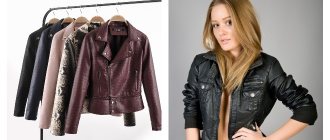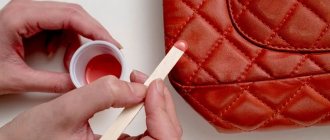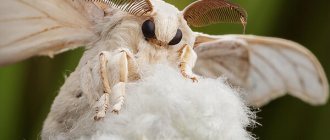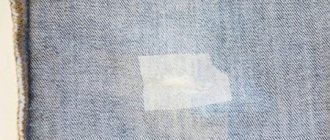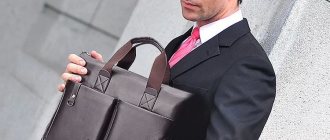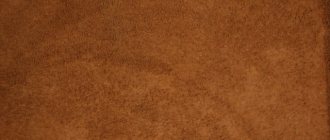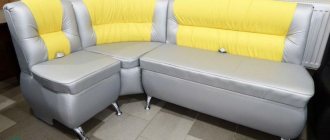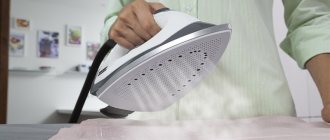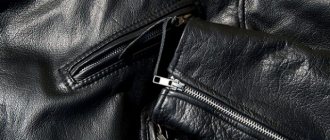It is not difficult to distinguish natural leather from artificial materials in only one case. When you buy a piece of leather in a store. Genuine leather is sold as whole, tanned animal skins, and its size is measured in square decimeters. In all other cases, you can easily buy a leather substitute instead of natural material, since manufacturers of leather clothing often use various kinds of materials that not only look like leather, but also have the basic characteristics of materials of animal origin.
About how to choose leather clothes so as not to buy an obvious fake. What are the differences between genuine leather and artificial leatherette? What is eco-leather, nubuck and what types of real leather are there and their brief characteristics.
In this video you will see how easy it is to sew leather on an industrial sewing machine (or Podolsk type) by installing a Teflon foot on it.
You can buy genuine leather only in specialized stores.
You can buy genuine leather only in specialized departments or fur studios. And as mentioned above, it is sold in whole skins. But the quality of the skin itself also varies and it depends not only on the type of raw materials, but also on the technology of processing the skins (curing) and the quality of the chemicals used for these processes, etc.
If you have ever taken apart leather clothes, then perhaps you have noticed that expensive things look beautiful not only on the outside, but also on the inside. The matte, almost smooth surface has a uniform color, and the leather itself is thin and durable. But we will not delve into these features; we will only say that the skin can be stretched, which makes its size increase, but its strength decreases. But you won’t be able to determine this, but you need to know why leather clothes are sometimes so inexpensive.
As for artificial leather, eco-leather and other leatherettes, they are all sold in rolls. This easily reveals its artificial “origin.”
How to identify skin by external signs
Since our site is aimed at those who are learning to sew with their own hands, the main emphasis is on leather as a material for sewing. But at the same time, these tips can also be used when purchasing ready-made clothes made from genuine leather.
First of all, genuine leather differs from artificial materials in its reverse side. It is called bakhtarma and is a loose fibrous surface. Bakhtarma resembles pile, sometimes similar to velvet, hence its name. It is important that the color and skins be the same on the front and back. This is exactly how leather skins are dyed, in one container. This rule applies to patent leather and any other leather with a decorative coating on the front side - on the back side there will still be fluff, no glued to the fabric, no smooth surface, otherwise it is not genuine leather. But it should be taken into account that manufacturers of artificial leather have long learned to fake the external signs of leather and cannot be guided only by them.
Another indirect difference can be considered the size of the skin. Since both the size itself and the defects found on the skin (holes, tears, thickenings, etc.) do not allow cutting out large parts, the presence of numerous seams on leather clothing is another sign. But again, conditional.
Any leather has a specific smell that will last for many years. This can also be considered a difference that helps identify natural leather, but not always. Reducing the cost of goods forces manufacturers to imitate even the smell of natural leather using special chemicals.
Well, mentioning that every leather item should have a label made of a piece of natural material in the shape of a stretched animal skin is only possible for general erudition. A diamond design means a synthetic material, a matting design means textiles.
How to distinguish leather from eco-leather and leatherette
- Tactile difference. Place your hand on the product being tested. Real leather will take heat from your hand and stay warm. Artificial leather will feel cold and your hands may sweat.
- Deformations. Bend the jacket, bag, gloves, etc. to be tested, you can also press on the skin. There will be creases and marks from the impact on the artificial leather. On genuine leather, creases and pressure marks will be straightened out in a matter of seconds.
The leatherette shows the remaining pressure mark. On the right is genuine leather, there are no traces of pressure.
- Bend the skin 180 degrees, the artificial one will change color, the real one will not:
Remaining creases and changed color are a sign of artificial leather.
- Ability to absorb water. Place a couple of drops on the product being tested. A product made of genuine leather will absorb water. Water will roll off the surface of the artificial leather.
On the left is the skin, water has begun to be absorbed. On the right is leatherette, water rolls off.
The water method is not applicable to genuine leather products treated with a protective composition against moisture.
- Distinctive tag. Products made from real leather are marked with a leather-shaped tag. The diamond-shaped tag means that this is faux leather.
On the left is a leatherette tag. On the right is genuine leather.
Other signs of natural material (leather)
So, in order to be able to identify genuine leather and be able to distinguish clothes made from artificial leather, remember these basic rules. But do not forget that you cannot rely on them 100%. Modern technologies for the production of fabrics and materials are capable of real miracles. And sometimes it is very difficult to distinguish the origin of the material of your bag, shoes, jacket, even for a specialist. And sometimes the fur on your sheepskin coat will smell like burnt feathers when melted, just like real sheepskin wool and a number of other signs will be present.
By the way, fire is one of the means by which you can certainly distinguish genuine leather from a good imitation or fake. If you set fire to the edge of the skin, for example with a candle, the burned area will tend to take on a rounded shape, pulling the rest of the surface into this circle. And if you burn the skin, for example with a cigarette, then a “burn” will remain on the surface, towards the center of which rays of “healthy” skin will reach. Of course, a bubble does not form like that of “living” skin, since it is already dehydrated, but there should not be a hole. Of course, if it’s not a super thin husky and it’s almost see-through. But a cigarette mark on artificial leather leaves a hole of impressive size with burnt edges and the appearance of a specific smell of burning synthetics.
Another way is to drop water and wait. Genuine leather will absorb moisture and darkening will be visible until the water dries completely. And excessive wetting with water leads to the fact that after drying the skin “tanns”, becomes hard and rough.
But the most accessible and proven method is provided to us by nature itself. If you press your palm against natural leather in the cool season, your hand will not feel cold from it. This is what distinguishes steering wheel braids made from real leather. And in a cold car you will immediately feel this difference. Artificial leather gives off coolness and “takes away” heat from the hand, and after you remove your hand, wet traces of perspiration may remain.
If you look at the pores of the skin through a magnifying glass, you can see that they are located chaotically and their depth is different. Factory-made material is woven on machines that are not capable of improvising like a living organism.
Caring for artificial leather
Everyday care of artificial leather products involves treating them with a damp cloth. Once a week, the item is cleaned and treated with a special spray or cream. Washing is recommended only for heavily soiled items.
Protective equipment helps to increase the service life of jackets or shoes and maintain their appearance. They are sold in shoe stores and are often recommended when purchasing a product.
The products protect against road chemicals and dirt. They should be used to treat shoes or outerwear in the evening, after wiping the surface of the product with a damp cloth.
Leatherette items should be stored away from heating appliances. When storing seasonal shoes for long-term storage, you need to insert spacers inside or fill them with paper. Jackets and bags are stored in covers.
If scratches or abrasions appear, you can paint leatherette with special spray paint. It is applied to the damaged area from a distance of 10 cm, then allowed to dry completely.
Deep scratches are treated with liquid leather. It fills the damage and prevents it from expanding.
Washing and drying
Leatherette can be washed by hand or in a washing machine. The product label indicates the acceptable washing option. Water temperature no more than 30 degrees. Gel products should be used for washing. When washing in a machine, turn off the spin and dry mode.
The washed item is shaken to remove any remaining water. Place on a horizontal dryer or hanger and dry away from heating appliances. Do not dry in the open sun.
To watch a video about cleaning fabric products:
How to iron
Leatherette is wrinkle resistant and folds rarely appear on it. Items that are made from poor quality material or that have been folded for a long time usually become wrinkled. You can smooth a faux leather item with an iron, steam or hot air.
- Ironing leatherette leather is allowed if there is a corresponding designation on the label. The iron should be set to 40–60 degrees. The product is turned inside out and ironed with light movements through gauze. Then the sleeves or trouser legs are filled with fabric and hung on hangers for half an hour.
- To steam a wrinkled item, you need to hang it on hangers. An iron with a steam function or a steam generator is used to process the item from top to bottom. The steam jet should be located at a distance of 10–15 cm.
- An improvised steam room helps soften rough leatherette. Hot water is turned on in the bathroom so that the room is filled with steam. Hang the item on hangers and leave it for half an hour. Then dry in a room away from heating devices.
- Small wrinkles can be removed with plain water. The item is laid out horizontally or hung. Using a sprayer, moisten the surface with water and leave until completely dry.
- Creases on the sleeves and collar are treated with glycerin. Using a cloth or cotton pad, apply glycerin to the wrinkled area. The item is left to dry completely.
- Light creases are straightened with hot air. The product is hung, a stream of hot air is directed from a hair dryer from a distance of 10 cm. When the leatherette is heated, it is stretched by hand and warmed up again.
- Fine wrinkles are straightened with vinegar. Mix one part 6% vinegar and two parts water. Spray the product with the mixture from a spray bottle. While it is wet, gently stretch the wrinkled areas with your hands.
To prevent things from becoming wrinkled, after washing they should be dried naturally, away from heating appliances. After drying, treat with a special cream for leather products.
What is eco-leather, split leather, nubuck, pressed leather?
In addition to natural materials (leather and suede), so-called nubuck is also produced. It is a cross between leather and suede, its front surface is porous and slightly rough. A large three-dimensional pattern is clearly visible on its surface, and on the reverse side of the nubuck you will see bakhtarma. Most often used for sewing men's shoes.
Eco-leather is a skillfully made material that is even superior to leather in many respects. It also “breathes”, but, nevertheless, it is not natural, but artificial leather. Often used to cover car seats and other interior parts.
Split leather is a natural material and represents real leather only in its rough, unprocessed form. In addition, this material uses the lower sawn-off part of the leather, hence the name. The best use for this material is sewing work gloves.
Pressed leather is the same as chipboard sheets, it seems to be made of wood, but not boards. In the same way, pressed leather is made from crushed chips of natural leather, but it is difficult to call it real leather, although all the important characteristics and differences of leather are present.
In this video you will see how to install a denim metal button on leather items.
